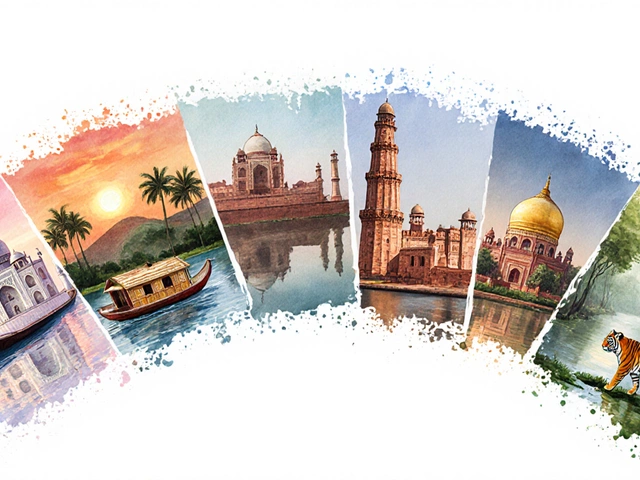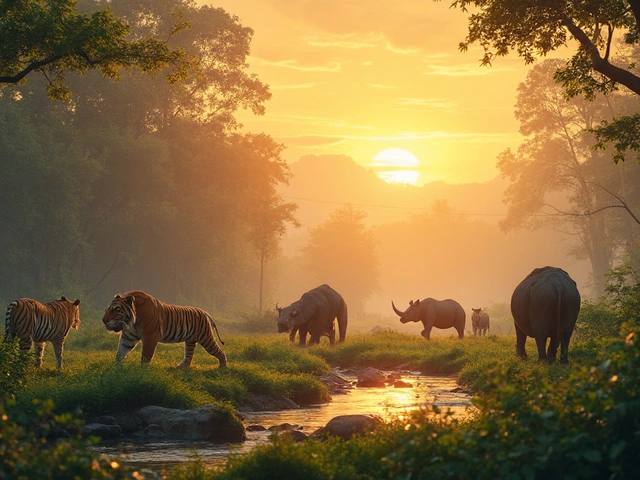Key Takeaways
- The biggest temple festival in India by sheer numbers is the Kumbh Mela, drawing over 30 million pilgrims in a single gathering.
- Puri Rath Yatra follows as the most iconic temple procession, with millions watching massive chariots move through the streets of Odisha.
- Thrissur Pooram and Kumbakonam Mahamaham are regional giants, each showcasing spectacular rituals and cultural fireworks.
- Visiting any of these festivals requires advance planning: secure travel, accommodation, and stay aware of crowd‑control measures.
- Respect local customs, stay hydrated, and use designated entry points to make the experience safe and memorable.
India’s religious calendar reads like a festival roadmap, and every temple town hosts an event that pulls crowds from near and far. But which one truly stands out in size and scale? The answer hinges on attendance, geographic spread, and the cultural weight of the rituals. Below we break down the top contenders, explain why Kumbh Mela tops the list, and give you a practical guide to joining the celebrations.
How We Measure “Biggest”
Before naming a winner, it helps to set the criteria:
- Attendance: Peak footfall recorded by local authorities or independent surveys.
- Geographic reach: How many states or regions the festival touches, either directly or through pilgrim flow.
- Duration: Number of days the core rituals run, plus any pre‑ and post‑festive activities.
- Ritual intensity: Presence of large‑scale processions, chariot pulls, or water‑based rites that require massive coordination.
Using these metrics, we can compare the major temple festivals across the subcontinent.
Kumbh Mela is a massive Hindu pilgrimage that rotates among four riverbank locations, drawing the largest crowds of any religious gathering on Earth
Kumbh Mela eclipses every other celebration when it comes to sheer numbers. Held every 12 years at one of four sacred sites-Prayagraj (Allahabad), Haridwar, Ujjain, and Nashik-the festival brings together pilgrims who bathe in the confluence of holy rivers. The 2019 Prayagraj Kumbh Mela recorded a peak of 30 million attendees on a single day, and total footfall for the 55‑day event topped 120 million.
Why does it matter for temple travellers? Even though the central ritual is a river dip, the surrounding towns are dotted with historic temples that host nightly aarti, cultural performances, and free food (langar) for pilgrims. This makes Kumbh Mela a hybrid of pilgrimage and temple festival, offering a once‑in‑a‑lifetime immersion into India’s spiritual fabric.
Puri Rath Yatra is an annual chariot procession in the Jagannath Temple, Odisha, where deities are taken out on massive wooden chariots
When you think of a temple festival, the image of towering, color‑splashed chariots rolling through crowded lanes probably comes to mind first. That’s Puri Rath Yatra, held every year in June or July. The three main deities-Jagannath, Balabhadra, and Subhadra-ride separate rathas (chariots) that weigh up to 100 tons each. Millions of devotees line the 70‑kilometer route from the temple to the Gundicha Temple, chanting and throwing flowers.
Attendance typically sits around 2-3 million, but the spectacle’s visual impact makes it a strong contender for the “biggest” title in terms of cultural reach and media coverage. The festival also spawns satellite events in Delhi, Kolkata, and even abroad, extending its influence far beyond Puri.

Thrissur Pooram is a spectacular temple festival in Kerala known for its elephant processions and percussion ensembles
Moving to the south, Thrissur Pooram is the crown jewel of Kerala’s temple calendar. Held in April or May at the Vadakkunnathan Temple, Pooram showcases 16 caparisoned elephants, over 100 percussion artists, and a fireworks display that lights up the night sky. The crowd averages 1 million, with visitors traveling from across India and the Gulf.
What makes Pooram stand out is its meticulous coordination of 21 stages, each featuring a different traditional art form. The festival also supports a vibrant local economy-handicraft sellers, food stalls, and boat rides on the nearby river add layers of experience for travellers.
Kumbakonam Mahamaham is a once‑in‑12‑years Hindu festival celebrated in Kumbakonam, Tamil Nadu, where the Kaveri River becomes the focal point for ritual bathing
Every 12 years, Kumbakonam transforms into a pilgrimage hub as the Mahamaham festival draws devotees to bathe in a specially prepared tank (the Mahamaham tank) that symbolically connects to all sacred rivers of India. The event attracts roughly 2 million pilgrims and includes elaborate processions of deities from over 30 nearby temples.
While the water ritual mirrors Kumbh Mela, Mahamaham’s scale remains regional. Still, its rarity and the sheer number of participating temples make it a standout on the list of large‑scale temple festivals.
Other Notable Temple Gatherings
Below are four more festivals that merit a mention for their size, cultural depth, or unique rituals.
- Meenakshi Temple Festival (Madurai, Tamil Nadu): Celebrated during the Tamil month of Chittirai, the festival sees over 500 000 pilgrims watching the celestial wedding of Goddess Meenakshi and Lord Sundareswarar.
- Jagannath Temple Festival (Nabakalebara, Odisha): A rare event held every 12-19 years where new idols are carved and installed, drawing crowds comparable to Rath Yatra.
- Vijayawada Kondagattu (Telangana): A massive fair centered around the Sri Kondagattu Anjaneya Swamy Temple, attracting 1 million visitors during its 10‑day run.
- Haridwar Kumbh (Uttarakhand): The winter edition of Kumbh Mela, with slightly lower numbers (around 15 million) but still a major festival.
Comparison at a Glance
| Festival | State / Region | Typical Attendance (Peak Day) | Duration | Signature Feature |
|---|---|---|---|---|
| Kumbh Mela (Prayagraj) | Uttar Pradesh | 30 million | 55 days | Mass river dip at Triveni Sangam |
| Puri Rath Yatra | Odisha | 3 million | 10 days | Three massive chariots |
| Thrissur Pooram | Kerala | 1 million | 2 days | Elephant procession & percussion |
| Kumbakonam Mahamaham | Tamil Nadu | 2 million | 5 days | Ritual bath in Mahamaham tank |
| Meenakshi Temple Festival | Tamil Nadu | 0.5 million | 10 days | Celestial wedding ceremony |
Planning Your Visit: Practical Tips
- Book early: Accommodation near the core venue fills up months in advance. Look for government‑run guest houses or certified homestays to avoid price gouging.
- Travel smart: For Kumbh Mela, the nearest railway stations are Prayagraj Junction (for Uttar Pradesh) and Haridwar Cantt (for Uttarakhand). Use pre‑booked taxis or official shuttle services.
- Stay hydrated and protected: Crowds generate heat. Carry a refillable water bottle, sunscreen, and a hat.
- Dress appropriately: Modest clothing respects the sanctity of the temples. For Rath Yatra, avoid bright reds if you plan to sit on a chariot-white or pastel is preferred.
- Follow crowd‑control instructions: Authorities use colored wristbands to manage entry. Listen to volunteers, and never attempt to push ahead of a queue.
- Bring cash: While many stalls now accept digital payments, small vendors often prefer exact change.
Common Pitfalls and How to Avoid Them
Even seasoned travellers can slip up. Here are the most frequent mistakes and quick fixes:
- Underestimating travel time: Traffic around major festivals can double normal commute. Add at least 30 % extra time to your itinerary.
- Skipping official information: Some “unofficial” tours promise front‑row seats but lead to hidden fees. Always verify with the state tourism board.
- Ignoring local customs: In Kumbh Mela, bathing is only permitted at designated ghats. Violating this can result in fines.
- Overpacking: Narrow alleys and crowded avenues make maneuvering with large luggage a nightmare. Travel light-just a backpack and a day‑bag.
FAQs
Which festival holds the record for the highest single‑day attendance?
The 2019 Prayagraj Kumbh Mela recorded about 30 million pilgrims on a single day, making it the world’s most attended religious event.
Can I attend Kumbh Mela without a religious background?
Absolutely. The festival welcomes anyone who wishes to witness the cultural spectacle. Non‑pilgrims should respect bathing restrictions and follow local guidance.
What is the best time of year to see the Puri Rath Yatra?
The Yatra usually falls in late June or early July, depending on the lunar calendar. Arriving a few days early helps you secure a good viewing spot.
Are there any safety concerns during Thrissur Pooram?
Crowd density can be high, especially near the elephant processions. Stay in designated zones, keep your belongings close, and follow the instructions of local volunteers.
How can I travel sustainably to these massive festivals?
Choose trains over flights where possible, opt for certified eco‑friendly accommodations, and use refillable water bottles to cut down plastic waste.
From the colossal river‑bank gathering of Kumbh Mela to the dazzling elephant pageantry of Thrissur Pooram, India’s temple festivals offer experiences that are as diverse as the country itself. Whether you’re after record‑breaking crowds, vivid rituals, or a deep dive into regional culture, you now have the facts to choose the right celebration for your travel style.



